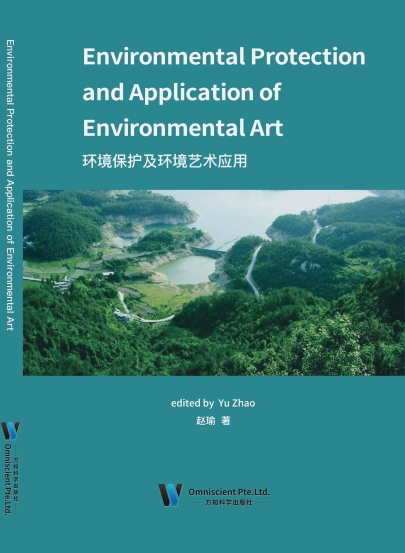
Preface
The progress of science and technology and the rapid development of global economy have greatly improved the quality of life of human society, but also brought a series of threats to human survival, such as environmental pollution and ecological deterioration, which has attracted the world’s attention in fields of environment, ecology and sustainable development. It has become a consensus of human society to protect the global environment and implement sustainable development. As a developing country with the largest population, to solve environmental problems is not only in line with China’s own long-term goal of sustainable development, but also an important embodiment of common interests of human society.
Using the concept of aesthetic description as an art level to explain the environmentalart problem is because aesthetic description itself, as an art research method, has a wide range and influence in the research of art evaluation. As the living space of human beings,environment is closely related to human life. The ultimate purpose of the formation and existence of environmental art is to provide a harmonious and beautiful living space and activity place for human beings. Therefore, the creation of modern environmental art must change the former focus on the carving of the entity, that is, to focus on the treatment of the external environment, and should take aesthetic care as the focus of environmental art creation, and turn the aesthetic focus of environmental art from the aesthetic object to the integration of the aesthetic subject and object. Excellent environmental art is the art of experience. It is the perceptual grasp of the life value and meaning of the work given by the people as the main body. Emotional life and meaning are the core of environmental art.
The occurrence of environmental art aesthetics can be divided into three stages according to the description of the aesthetic process: first, the feeling of many complex landscape phenomena such as environmental material characteristics, such as elements, order and time, etc., and the perception image with pleasure generated by the superposition of various feelings; second, the aesthetic image of environmental art is formed when the perception image is consistent with the original emotional state; and finally, the value judgment of aesthetic result, which can be correctly understood and expressed through the synthesis of subject evaluation and object evaluation.
前 言
科学技术的进步和全球经济的迅猛发展,在极大地改善了人类社会生活质量的同时,也带来了环境污染和生态恶化等一系列威胁人类生存的问题,从而引起了世界各国对环境、生态、可持续发展等领域的广泛关注。保护全球环境,实施可持续发展,已成为人类社会的共识。作为人口最多的发展中国家,解决好环境问题,既符合中国自身可持续发展的长远目标,也是人类社会共同利益的重要体现。
用审美描述这样一个艺术层面的概念来阐述环境艺术问题,是因为审美描述本身作为一种艺术研究方法,在艺术评价的研究中具有广泛性和影响力。环境作为人类生存的空间,与人的生活息息相关,环境艺术的形成和存在的最终目的是为人类提供和谐美好的生存空间和活动场所。因此,现代环境艺术创造必须改变以往只注重实体的雕琢,即把注意力全部集中在外部环境的处理上,而应把审美关怀作为环境艺术创造的重点, 将环境艺术的审美重心由审美客体转向审美主客体的融会统一。优秀的环境艺术是体验的艺术,是作为主体的人将强烈的感情色彩赋予作品生命价值与意义的感性把握,情感生命、意义是环境艺术关注的核心。
环境艺术审美的发生依据审美过程的描述可分为三个阶段:首先是对环境物质特征,如要素、秩序时间等许多复杂景观现象的感觉,多种感觉叠加生成具有愉悦性的知觉象;其次是当知觉表象与原有的情感状态相符时形成环境艺术的审美意象;最后是审美结果的价值判断,这要通过主体评价和客体评价的综合才能被正确地认识和表达出来。

Yu Zhao, female, born in Chongqing City in September 1980. She is the director of the department of environmental design of the College of Arts and Sciences Yunnan Normal University. She has been engaged in environmental design teaching and arts design research. She participated in the landscape planning and design of Panlong River in Wenshan Prefecture, Yunnan Province, the space design of Dianchi Golf Club, the office space design of Lucky Air. She committed to environmental design teaching and practice of research and mining activities. She participate in the research work of “evaluation on the use of landscape architecture in Dianchi Wetland Park”, “Research on the protection and development of traditional villages under the cause of sustainable developmentTaking the old village of Leju in Kunming as an example”.
赵瑜,女, 1980 年 9 月生,重庆人,云南师范大学文理学院环境设计专业教研室主任。常年从事环境设计教学与艺术设计研究工作,曾参与云南省文山州盘龙河景观规划设计、 滇池高尔夫会所空间设计、 昆明祥鹏航空公司办公空间设计等社会方案。并致力于环境设计教学与实践的研究和挖掘活动。参与“滇池湿地公园景观建筑使用评价”“可持续发展事业下的传统村落保护与发展研究——以昆明乐居老村为例”等项目研究工作。